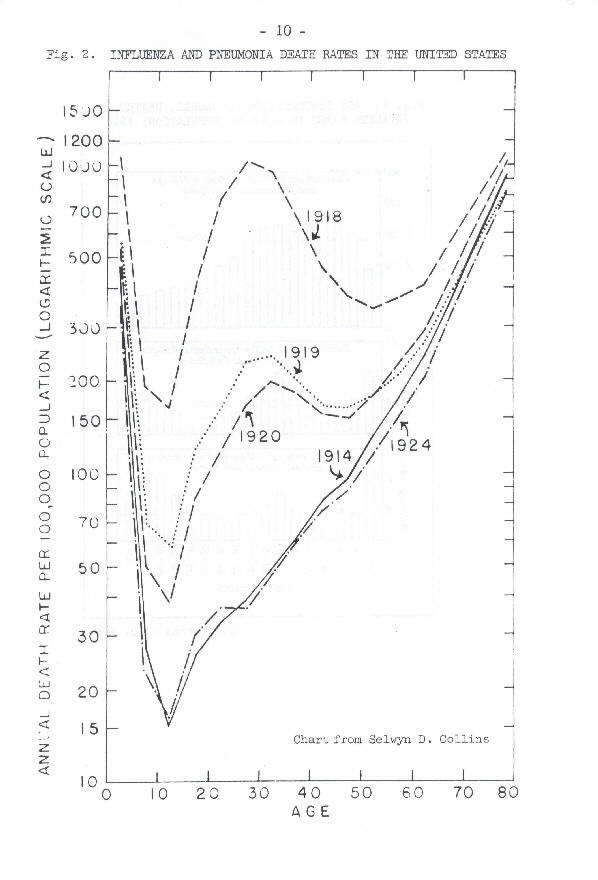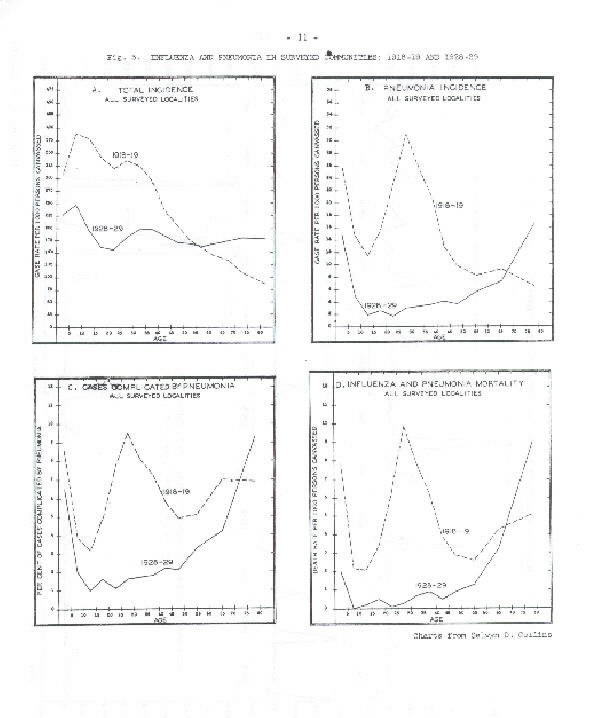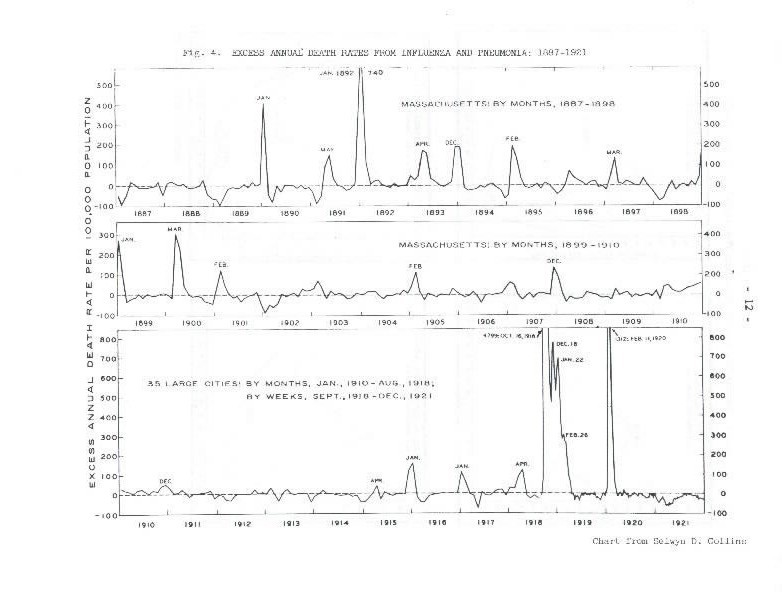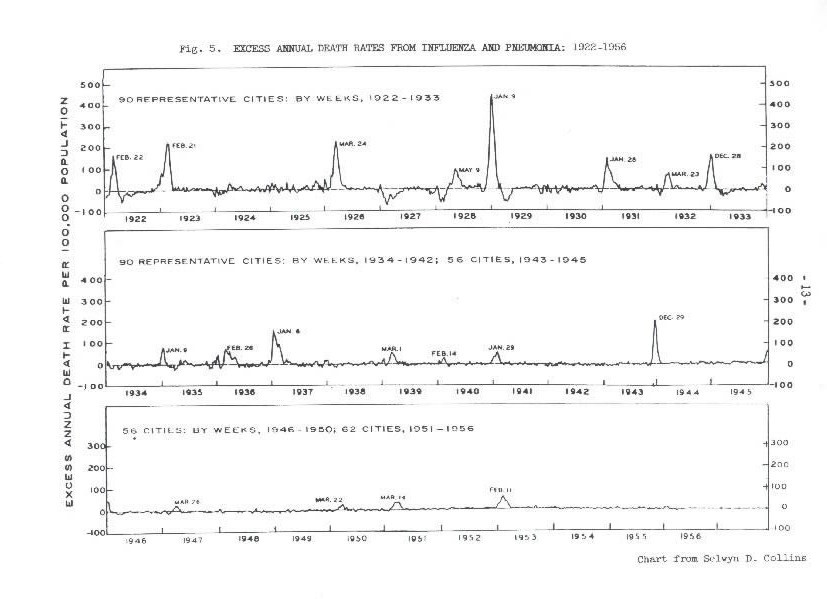Dauer, C.C. "The Pandemic of Influenza in 1918-19." Washington, D.C.?: Public Health Service, National Office of Vital Statistics, 19 July 1957.

The Navy Department Library
The Pandemic of Influenza in 1918-1919
US Department of Health, Education and Welfare
Public Health Service
National Office of Vital Statistics
The recurrence of pandemic influenza with the killing power of the 1918-19 pandemic has always been considered a possibility, but the probability of anything so lethal is lessened by the fact that several weapons are now available with which to combat a severe epidemic. The recent emergence of a variant of type A influenza virus which is antigenically different from any strains previously isolated, and its rapid spread throughout Southeast Asia, has reawakened interest in what occurred in 1918-19. The following description of the 1918-19 epidemic of influenza in the United States has been prepared in response to that request. It is intended merely to refresh our memories of its highlights and characteristics. It is not an exhaustive review.
Description
The pandemic of influenza in 1918-19 which swept over nearly every continent and island of the whole globe has been described as one of the great human catastrophies. There are excellent descriptions of epidemics and pandemics as far back as the year 1500, and various records of epidemics since the 1918-19 holocaust. Many of them were relatively mild infections, while others were severe, but none of them showed the extraordinary high mortality in young adults that characterized the 1918-19 pandemic and its aftermath in 1920. The greatest amount of mortality in epidemics prior to and subsequent to 1918-19 was found in children under 1 year of age and in persons 65 years and over.
Frost, in one of his reports, pointed out that influenza and pneumonia mortality rose sharply in some cities in the United States in December 1915 and January 1916, which may or may not have been related to the 1918 epidemic. In January 1916, influenza was reported to be epidemic in 22 States, but it was described as a mild type of illness.
As early as December 1917, influenza was prevalent in Camp Kearny, California, and in other Army camps in January 1918, but the disease was said to be mild. In the spring, localized outbreaks occurred in the civilian population of the United States, and mortality from pneumonia rose sharply in certain cities. In March and April, Camp Funston, Kansas, experienced three waves of influenza. The first two affected all types of personnel, and the third, which occurred late in April, was predominantly in recruits who arrived shortly after the second wave. Mild epidemics of influenza were reported in various localities in Western Europe in April and May of 1918, and in June and July more extensive outbreaks occurred in Great Britain and in Europe, China, India, the Philippine Islands, and Brazil. In these countries, mortality rose moderately. The 1918-19 epidemic was often referred to in the United States as "Spanish influenza," but there is no reason to believe that it originated in Spain. Indeed the occurrence of influenza in the United States in the spring of 1918 may have preceded that which occurred in Spain.
During August 1918, epidemics of influenza were reported in Greece, Sweden, Switzerland, Spain, the West Indies, and late in the month it appeared almost simultaneously in Camp Shelby, Mississippi, and Boston, Massachusetts. In September, it appeared in rapid succession in other Army camps and in the civilian population along the Atlantic seaboard and the Gulf of Mexico and spread rapidly westward over the country. By October, the epidemic had involved the entire United States, except isolated places and some mountain areas. The interval between the peaks of the epidemic in Boston and San Francisco was about 4 weeks, and the peaks in the number of deaths usually were reached in about 1 month following the beginning of the epidemic in a community or area. As a rule, epidemics affected rural areas later than cities in the same sections. In some areas there was a recrudescence of the epidemic in January and February 1919, which was most marked in cities where the autumn epidemic was less severe. Thus the influenza epidemic of 1918-19 in the United States was characterized by a relatively mild phase in the spring of 1918, an explosive outbreak with high mortality in the fall, and a third phase or recrudescence early in 1919.
Information regarding morbidity of the epidemic is limited. The most reliable as well as informative data on case incidence in the civilian population are those published by Frost and Sydenstricker who made house-to-house surveys in a number of localities in urban and rural areas located in different parts of the country. These were made in December after the first wave of the epidemic had subsided. It was found that incidence varied from 15 percent in Louisville to 53 percent in San Antonio, Texas, and that pneumonia varied from 5.3 cases per 1,000 population in Spartanburg, South Carolina, to 24.6 in some small towns in Maryland; but the pneumonia rate did not correlate with the influenza attack rate. The death rate appeared to parallel the pneumonia attack rate rather than that of influenza itself. Figure 1 shows the case rates, case fatality rates, and mortality rates by age that were found in these populations. This chart, taken from a paper by Frost, indicates that incidence was highest in children and young adults; death rates were relatively high in infants, young adults, and persons over 60 years of age. Attack rates and mortality rates were found to be lower in the nonwhite populations. While case fatality rates were relatively high in young adults, they were highest in the very young and the very old.
The incidence and mortality of influenza in military personnel in 1918-19 has been described in great detail in Epidemiology and Public Health by Vaughan, and in Volume 9 of the history of the Medical Department of the United States Army in the World War. [See also the Surgeon General's account in Annual Report of the Secretary of the Navy, 1919 -- Miscellaneous Reports. About 90 percent of the men in military service in World War I were young adults between 20 and 35 years of age. Consequently, the Armed Forces were seriously affected, as were the same age groups in the civilian population. In the Army over a million men were hospitalized for influenza and pneumonia, and of these there were more than 44,000 deaths. There were approximately 5,000 deaths among Navy personnel. Hospital admission rates and death rates for American troops stationed in Europe were lower than for troops in the United States. The large number of recruits concentrated in close quarters probably accounted for higher rates in the latter. In the camps having the larger numbers of trainees, incidence and mortality was highest, and in all camps the rates were higher in recruits than in seasoned troops. The crowding in camps probably favored the spread of secondary invading organisms as well as the etiologic agent of influenza. The peak of the epidemic was reached in September in Navy personnel and about the middle of October in the Army. A secondary rise in incidence of these respiratory diseases occurred in the Army in January and February 1919, but it was limited to troops stationed in Europe.
When appropriate adjustments are made for differences in the age and sex distribution of military and civilian populations, it appears that the death rate was about one-fourth higher in the Army than in the civilian population of the United States. It is reasonable to assume that this difference was largely due to greater crowding in the recruit population of the Army.
Figure 2 by Collins shows mortality rates from influenza and pneumonia by age in 1918 as compared with certain other years. The relatively high mortality in young adults in 1918 and the 2 years immediately following seems to have been characteristic of that period and was not found in epidemics prior to or subsequent to this 3-year period.
It has been estimated that there were about 20,000,000 cases of influenza and pneumonia in the United States in 1918-19, with approximately 850,000 deaths. In 1918 alone, 464,959 deaths from influenza and pneumonia were registered in the registration States and the District of Columbia as compared with 115,526 in 1917. This includes deaths in the Army, Navy, and Marine Corps which occurred in registration States. Eighty percent of the deaths in 1918 occurred in the last 4 months of the year.
The numbers of deaths from influenza and pneumonia by age in registration States in 1917, 1918, and 1919 are shown in the table. A number of States in which Army camps were located are not included in this table, so a considerable number of deaths of civilians and of military personnel for 1918-19 are missing which accounts for the difference in an estimated total of 850,000 for the United States and the figure of 650,399 for the registration States. In 1918 the death rate for males
Influenza and Pneumonia Mortality by Age: Death-Registration States, 1917-19
(For 1917, area includes 27 States and the District of Columbia; for 1918, 30 States and the district of Columbia; and for 1919, 33 States and the District of Columbia)
| Age | 1917 | 1918 | 1919 |
|---|---|---|---|
| Number of deaths | |||
| All ages | 115,526 | 464,959 | 185,440 |
|
|||
| Under 1 year | 22,207 | 38,428 | 27,736 |
| 1-4 years | 12,859 | 49,699 | 21,133 |
| 5-14 years | 3,319 | 28,054 | 10.598 |
| 15-24 years | 4,861 | 78,158 | 20,381 |
| 25-34 years | 6,915 | 126,792 | 32,159 |
| 35-44 years | 9,387 | 60,902 | 20,690 |
| 45-54 years | 10,652 | 28,596 | 14,043 |
| 55-64 years | 12,571 | 19,632 | 12,530 |
| 65-74 years | 14,771 | 17,643 | 13,065 |
| 75-84 years | 13,224 | 11,829 | 9,548 |
| 85 years and over | 4,600 | 3,680 | 3,173 |
| Not stated | 160 | 1,546 | 384 |
| Rate per 100,000 population | |||
| All ages1 | 164.5 | 588.5 | 223.0 |
|
|||
| Under 1 year | 1,474.5 | 2,273.3 | 1,594.2 |
| 1-4 years | 211.5 | 718.0 | 293.9 |
| 5-14 years | 24.0 | 176.2 | 63.3 |
| 15-24 years | 38.9 | 580.5 | 141.4 |
| 25-34 years | 59.3 | 992.6 | 235.9 |
| 35-44 years | 98.1 | 554.8 | 181.0 |
| 45-54 years | 148.8 | 347.8 | 163.9 |
| 55-64 years | 281.4 | 381.9 | 233.2 |
| 65-74 years | 614.6 | 646.3 | 459.6 |
| 75-84 years | 1,503.0 | 1,179.0 | 913.9 |
| 85 years and over | 3,187.4 | 2,230.6 | 1,842.2 |
1 Includes deaths at ages not stated.
was 669.0 per 100,000 population; for females, 507.5. At ages 25 to 34, the rate was 1,216.6 for males and 781.4 for females. These excessively high mortality rates profoundly influenced the estimated average length of life calculated for the year 1918. It was reduced 24 percent from 1917 to 1918 for males and 22 percent for females. However, these estimated average lengths of life in years returned to their previous trends in 1920.
Etiology
Pfeiffer isolated an organism in 1892 variously referred to as Pfeiffer bacillus or influenza bacillus which was accepted by many as the causative agent of influenza. However, in 1918, various observers failed to find this organism in many cases, antemortem or postmortem. A report on sputum cultures taken from 47 individuals in Baltimore during the epidemic showed that streptococci were present in 24 sputums, staphylococcus in 1, pneumococcus in 15, and the influenza bacillus in 8. In cultures taken in various Army camps prior to and during the epidemic of influenza in the fall of 1918, varying proportions of persons were found to carry streptococci, pneumococci, and the Pfeiffer bacilli. Such variations were also found in cultures from the bronchi or lungs at autopsy, and differences were found from camp to camp. The proportion of persons carrying streptococci or some other secondary invader did not remain constant, being replaced from time to time by another bacterium.
It was the impression of many in 1918 that an unrecognized virus was the primary cause of influenza and that the streptococci, pneumococci, and influenza bacilli were secondary invaders which might be termed "bacterial hitch-hikers." Attempts by two groups of investigators to transmit the infection by nasal instillation of filtered and unfiltered secretions from influenza cases in human volunteers were not successful. Nor could they produce influenza in the volunteers by nasal instillations with Pfeiffer bacilli.
Prevention and Control
It often happens that when a severe outbreak of a disease occurs many measures are applied, some of which appear to be extreme and dictated by panic. In 1918, which was no exception, isolation of cases and quarantine of contacts were applied vigorously in some areas, but there is little evidence to indicate that these measures were successful in preventing introduction or spread of the disease. Closure of schools and prohibition of public gatherings likewise were of doubtful value. The use of face masks to protect the wearer against infection had its advocates. The use of germicidal gases to destroy the organism was suggested. The use of a vaccine containing the influenza bacillus was advocated, but as one would expect, no value could be demonstrated. If a vaccine containing the viruses now known to cause the disease had been made available early in the epidemic, it is doubtful whether it would have been effective, since the epidemic in the fall of 1918 spread with great rapidity.
In 1922, Victor Gaughan stated in retrospect that the most reasonable administrative action that could have been taken was to direct efforts toward relief measures, namely, medical and nursing care and hospitalization.
Influenza Since 1918
Since 1920 influenza has occurred frequently but irregularly. Generally, incidence has been highest in children (figure 3) and the epidemics have been accompanied by some increase in mortality, but the excess in deaths has gradually declined. The excess in the death rates over the "expected" in 1918-19 was 598, 92 percent of which was caused by influenza and pneumonia. In 1928-29, influenza and pneumonia contributed 62 percent of the excess mortality. In recent years, mortality from all causes has not shown a marked rise during influenza epidemics, and deaths attributed to influenza and pneumonia have been increasingly fewer in numbers. The principal impact of influenza epidemics in the past 10 to 20 years as shown by Collins (see figures 4 and 5) was an excess of deaths in causes other than influenza and pneumonia such as heart disease and other chronic diseases. These deaths occur mainly in the older age groups. In a few instances such as the epidemic in Liverpool, England, the excess of deaths of old persons was considerable.
Little is known about the true prevalence or incidence of influenza in recent years, because reporting of individual cases is unreliable. The disease cannot be clinically differentiated from other types of upper respiratory infections which may also be occurring during an epidemic of influenza, and it is not practical to obtain laboratory diagnosis of all suspect cases. Absenteeism rates in schools, industrial, or other working groups may rise, but such indices are more useful in alerting health officers to the possibility of an influenza epidemic than in providing accurate figures on incidence. A rise in absenteeism rates to 30 or 40 percent in school populations is not an uncommon occurrence.
Much of the descriptive material and charts on the 1918-19 epidemic used in this report were obtained from published reports or books by W.H. Frost, Edgar Sydenstricker, Victor Vaughan, and Eugene Opie. The publications of Selwyn Collins were a valuable source of information on characteristics of epidemics of influenza in the United States prior to and subsequent to 1918.
C.C. Dauer, M.D.
Medical Advisor,
National Office of
Vital Statistics





[The opinions expressed in this publication are those of the author and do not necessarily represent the views of the Naval History & Heritage Command].
[END]



